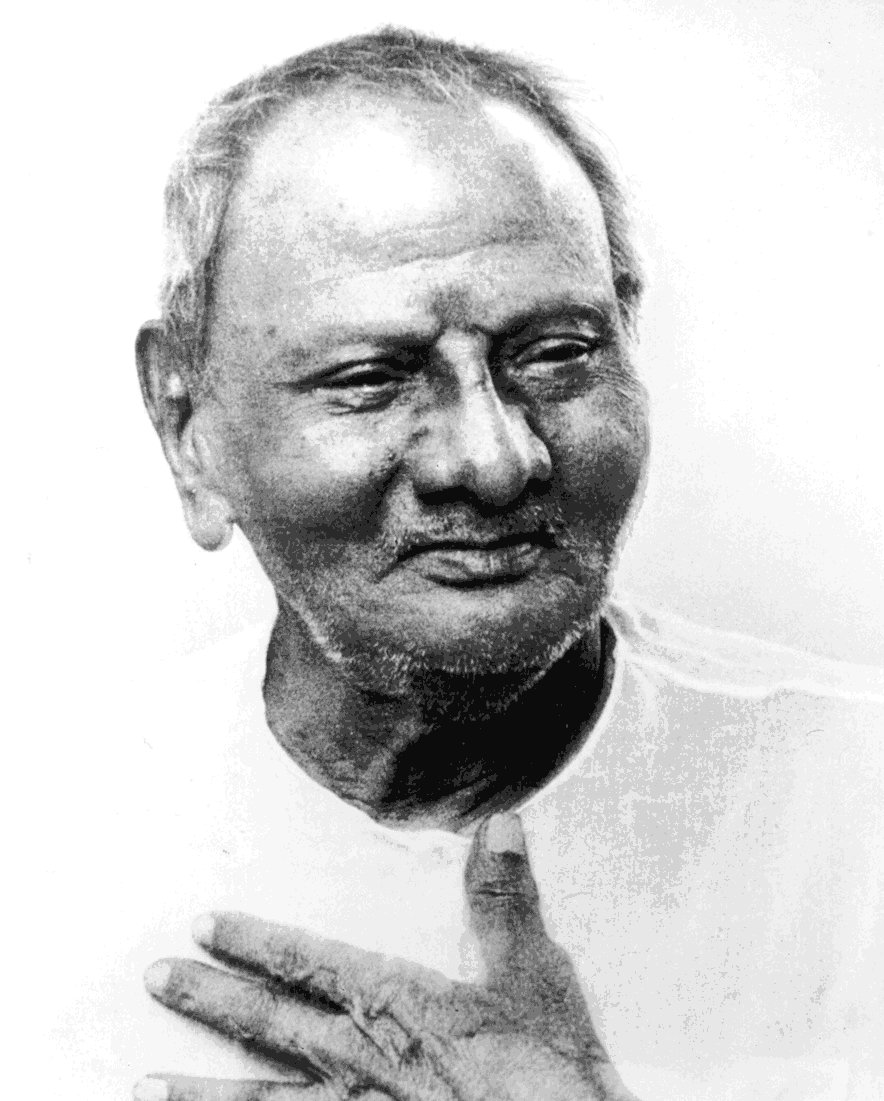
Wiki / NisargadattaMaharaj
Inhaltsverzeichnis: (verbergen)
 Nisargadatta Maharaj, 1973 |
Nisargadatta Maharaj wurde schätzungsweise im März 1897 in Mumbai (Bombay) geboren. Es sind nur wenige Daten aus seiner Jugend bekannt. Sein Geburtsname war Maruti Kampli. Sein Vater war ein armer Mann, der einige Zeit als Hausan-
gestellter in Bombay arbeitete und später als Bauer im Dorf Kandalgaon in Ratnagiri im Distrikt Mahrashtra. Maruti genoss kaum Schulbildung. Als Kind half er seinem Vater bei der landwirtschaftlichen Arbeit. Als Maruti achtzehn Jahre alt war, starb sein Vater und hinterließ eine siebenköpfige Familie.
Es wird berichtet, dass er schon früh den religiösen Ausführungen eines frommer Brahmane namens Vishnu Haribhau Gore lauschte, der ein Freund seines Vater war. Nach dem Tode seines Vaters ging Nisargadatta nach Bombay, um dort kurzzeitig als schlecht bezahlter Bürobote und später als selbständiger Kleinhändler für Kinderkleider und Tabakwaren zu arbeiten, womit er sich einen gewissen finanziellen Rückhalt sicherte. Nisargadatta war Raucher und verkaufte Beedies, beliebte in-
dische Zigaretten, die in Tendu-Blättern (statt in Papier) eingerollt sind. 1924 heiratete er und bekam einen Sohn und drei Töchter.
Als er 34 Jahre alt war, nahm ihn sein Freund Yashwantrao Baagkar mit zu einer Abendveranstaltung seines Gurus Sri Siddharameshwar Maharaj. Dieser gab ihm ein Mantra und Anweisungen zur Meditation. Drei Jahre später hatte Maruti Visionen und verfiel in eine Art Trance. Etwas explodierte in ihm und er gebar das kosmische Bewusstsein und ging im ewigen Leben auf, wobei er seine persönliche Identität verlor. Er nahm den neuen Namen Nisargadatta an und betrieb weiterhin seinen Laden, doch sein Interesse an Profit erlosch. Später gab er sein Geschäft auf und lebte eine Zeit lang
als Bettelmönch (Saddhu), der barfuß durch das Himalaya-Gebirge wanderte. Den Rest seines Lebens verbrachte er
lehrend in Mumbai als der Nachfolger seines Gurus Sri Siddharameshwar Maharaj und Oberhaupt der Inchegari-Zweigs
von Navanath Sampradaya.
Nach Angaben des Lexikons der östlichen Weisheitslehren (Scherz-Verlag, 1986) hat Nisargadatta, der selbstverwirklichte Weise, keine Schule gegründet oder Philosophie gelehrt, sondern nur über das gesprochen, was er selbst erkannt und erfahren hatte, sein eigenes, wirkliches Selbst. Seine Anweisungen und Antworten auf Fragen zielen auf Selbsterfor-
schung im Sinne von Ramana Maharshi. Er war ein bedeutender Advaita-Lehrer, der in seinem Dachgeschoss in den
Slums in Mumbai brillante, aphoristische ad hoc Vorträge hielt und ein minimalistisches strenges Jnana-Yoga lehrte.
Maurice Frydman hat sie in den letzten zehn Lebensjahren von Nisargadatta zusammengetragen und ins Englische
übersetzt. Dadurch wurde Nisargadattas Lehre im Westen bekannt.
1976 fand sich unter den Zuhörern von Nisargadatta auch ein Mann namens Ramesh Balsekar ein. Und als der Krebs
im Endstadium Nisargadatta immer mehr am Sprechen hinderte, forderte er Ramesh auf, die Fragen der anwesenden Besucher anstelle seiner zu beantworten. Nisargadatta starb mit 84 Jahren im September 1981 in Bombay.
| Quelle der biographischen Daten: ► Teilweise entnommen aus Sri Nisargadatta Maharaj, Ich bin, Gespräche mit Sri Nisargadatta Maharaj. Teil 1, J. Kamphausen Verlag, 4. Auflage 1998 |
| Quelle: ► Dr. Stephen H. Wolinsky, US-amerikanischer Lehrer für Selbsterforschung und Kaschmirischer Shivaismus, Begründer der Quantenpsychologie, Das Tao des Chaos. Quantenbewußtsein und das Enneagramm, Alf Lüchow Verlag, April 1996 |
| Referenz: ► Gelöschte Zusammenfassung (der Lehre) von Nisargadatta Maharaj, präsentiert von der Webseite Zentrum-fuer-Psychosynthese.de, undatier |
Ich bin. Gespräche mit Sri Nisargadatta Maharaj, Teil 1, J. Kamphausen Verlag, 4. Auflage 1998, 6. Auflage 2004
Die ultimative Medizin, Noumenon, 17. September 2009, 2. überarbeitete Auflage 9. August 2013
Prior To Consciousness
Personal avowals
Maharaj's reply on several indignant protests over his incessant smoking of biddies (hand-made Indian cigarettes) that an enlightened man continued to smoke
Recommendations

Prior To Consciousness
Dialogues
The Sense of "I am" (Consciousness)
|
Links zum Thema Nisargadatta MaharajLiteratur
Literature by N. Maharaj (engl.)
Literature about N. Maharaj (engl.)
Externe Weblinks
External web links (engl.)
Audio- und Videolinks
Audio and video links (engl.)
|
Hawkins